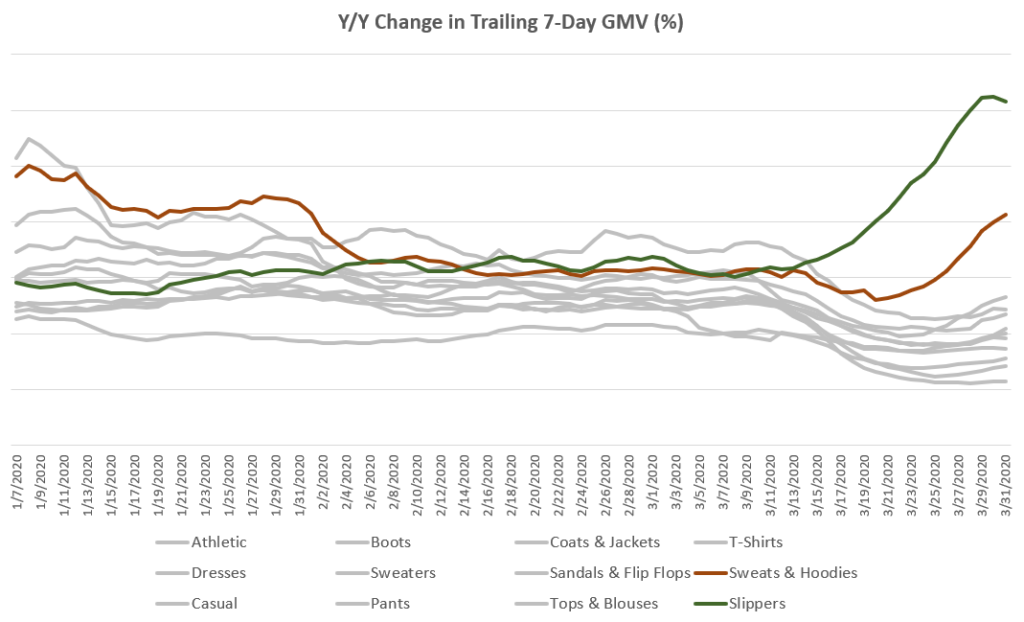This is part three in an ongoing series. Prior posts are available here:
- Part 1 covered GMV trends from Jan 1 – Mar 17, 2020
- Part 2 covered GMV trends from Jan 1 – Mar 22, 2020
Since our post last week, even more communities around the world have been locked down and more people are working from home. However, policies have been in place in many locales for multiple weeks now, and this is becoming the “new normal” for many of us. Because there are so many changes on a daily basis, we’ve built a COVID-19 resources page to help you keep up with major developments in e-commerce. This blog post is designed to provide an update on Rithum aggregate gross merchandise value (GMV) trends.
First, some important points to understand before digging into the data:
- This data is based on marketplaces GMV aggregated across our entire customer base globally and compares Jan 1 – Apr 1, 2019 against Jan 1 – Mar 31, 2020. The final dates are offset by one day due to leap year.
- The data presented below highlights only specific marketplace categories, which are merely a subset of all categories. Because marketplaces have different category structures, the data is presented using categories that have been standardized by Rithum.
- This data is not a proxy for overall e-commerce activity or the performance of any individual business, including Rithum or any individual marketplace.
- The data shown below is based on a year-over-year comparison of trailing 7-day GMV and is expressed as percentage growth, but with actual numbers removed. The Y-axis scale is different on each graph.
- All calculations are done in USD. Global currencies are converted to USD using the conversion rate on the day of the order. These results are not normalized to account for fluctuating exchange rates. Please note that there has been significant volatility in various currencies, such as GBP, which may impact these trends.
Broad Categories
Looking at the four broad categories we reviewed in each of the first two posts, the “health and beauty” and “computers/networking” categories were still the strongest in terms of year-over-year growth. Through the end of March, growth remained particularly strong for the “computers/networking” category, still driven by the increasing number of people that require home office gear. Last week we speculated that the “clothing/shoes” and “sporting goods” categories had bottomed and were turning the corner. Data through the end of March seems to confirm we were correct.


In prior posts we’ve focused on subcategories directly impacted by COVID-19, including items in the news such as toilet paper, hand sanitizer, and more. In this post, we take a deeper dive into categories that have initially been negatively impacted: “clothing/shoes” and “sporting goods”.
Apparel (Clothing/Shoes/Accessories)
To see if there were specific segments leading the “recovery” in apparel, we plotted some of the larger subcategories below. Most subcategories have followed the same general path of the overall apparel category pictured in the graph above, suggesting that the downturn was relatively widespread.
Over the last two weeks, however, the “sweats and hoodies” subcategory has grown faster year-over-year than the other larger subcategories. The “slippers” subcategory is not one of the larger subcategories but was included here to highlight the absence of a strong decline and the significant uptick in growth over the last two weeks. We conclude that consumers are focusing on comfort as they hunker down in their homes.


Sporting Goods
Growth rates for 2020 in the “sporting goods” category were relatively steady early in Q1, followed by a slight decline as the crisis took hold and a recent uptick (see graph under the Broad Categories header above).
Specific outlier subcategories highlight the trend we’ve seen over and over in the data: consumers are preparing to be at home for an extended time. Note that the outlier subcategories are not necessarily the largest subcategories in the “sporting goods” category. “Golf Clubs” is one of the larger subcategories and was included as a comparison to overall growth as well as to the outliers.


Conclusion
As we reached the end of Q1, we continued to see consumers focused on items needed to spend more time at home, including computing equipment for work, slippers for comfort, and home exercise equipment to stay in shape. For now, we continue to see evidence that a bottom has been reached in the harder hit categories. As we stated last week, things continue to change rapidly and we will continue to monitor these trends.
In closing, we would like to reiterate from our original blog post that the COVID-19 pandemic has created extreme turmoil globally. The impact on supply and demand and the way people work is in the news daily and can be seen in the data above. The impact seems trivial relative to the personal toll. Nevertheless, the job of ensuring that food, medicine, and other essentials make their way to people globally is important to keep society functioning as normally as possible while we work our way through the current pandemic. So, in addition to thanking medical professionals, researchers, and others for their heroic efforts in treating the sick and trying to find a cure, we’d like to thank those of you in the factories, in the grocery stores, in the distribution centers, and in the delivery trucks helping to bring us the items we need to live.



